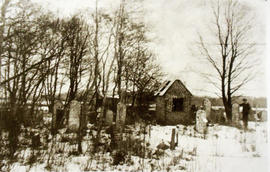Title and statement of responsibility area
Title proper
Pasvitinys Photograph Series
General material designation
- Photographic material
Parallel title
Other title information
Title statements of responsibility
Title notes
Level of description
Series
Repository
Reference code
Edition area
Edition statement
Edition statement of responsibility
Class of material specific details area
Statement of scale (cartographic)
Statement of projection (cartographic)
Statement of coordinates (cartographic)
Statement of scale (architectural)
Issuing jurisdiction and denomination (philatelic)
Dates of creation area
Date(s)
Physical description area
Physical description
Publisher's series area
Title proper of publisher's series
Parallel titles of publisher's series
Other title information of publisher's series
Statement of responsibility relating to publisher's series
Numbering within publisher's series
Note on publisher's series
Archival description area
Custodial history
Scope and content
The Pašvitinys (English spelling: Pasvitinys) Photograph Series includes various combinations of the Blecher family members, with Hirsh being the head of this family. One photograph is of Hirsh alone, another with his wife and their son and grandchildren, and two of Yosef Blecher (Hirsh's grandson) visiting his father's grave (Yisrael Blecher, Hirsh's son).
The chaotic pattern in Eastern Europe and nearby regions in the first half of the 20th century – mostly as a result of the two World Wars – consisted of sporadic occupation, independence, and reoccupation of territories. Jewish people were not treated kindly in Pasvitinys, despite relatively civil relations pre-1900. After a blood libel broke out into a pogrom against Jews in 1900, the Jewish people of this town and those around it were treated with suspicion and hostility by their Christian neighbours. At the outbreak of World War I, the Russian military exiled all Jewish people from the town into Russia, similarly to what occurred in other shtetlach, and once again in a similar fashion, only about half of the pre-WWI Jewish population returned to their home shtetl post-WWI. During independent Lithuania in the interwar years, Zionism thrived year as it had for years, with active Zionist members in all circles of Jewish life until around 1925. This is when the population of the town began to dwindle, with the 1930s seeing the largest mass immigration of Jewish people from Pasvitinys to South Africa mostly, and also to America and Israel. This exodus was encouraged following increased hostility towards Jews as the economy in pre-WWII Lithuania reached crisis point and Jewish-run businesses were boycott. When the Soviet Union annexed Lithuania in 1940, the remaining Jewish people had their property nationalized and Zionist organizations were banned. When WWII broke out between the Soviet Union and Nazi Germany, the rapid advance of Nazis meant that Pasvitinys was easily occupied, and Lithuanian nationalists supported their cause, assisting with mistreatment and violence against Jewish people. This ended with a Yom Kippur massacre in October 1941, which also included Zhager Jews. [Source: https://www.jewishgen.org/yizkor/Lithuania6/Lit6_191.html]
The town of Pašvitinys (English spelling: Pasvitinys) is named as such in Lithuanian, as Poshvityn in Russian, as Poszwityń in Polish, and as Pashvitin in Yiddish.
Notes area
Physical condition
Immediate source of acquisition
Donated by The South African Jewish Board of Deputies Archive
Arrangement
Language of material
Script of material
Location of originals
Availability of other formats
Restrictions on access
Terms governing use, reproduction, and publication
Unless otherwise stated the copyright of all material on the Jewish Digital Archive Project resides with the South African Jewish Museum.
Finding aids
Associated materials
Accruals
Alternative identifier(s)
Standard number area
Standard number
Access points
Subject access points
Place access points
Name access points
- SAJBOD Archives (Donation)
- Lithuanian and Surrounding Towns Collection (Collector)
- SAJM Jewish Digital Archive Project (JDAP) (Custodian)





